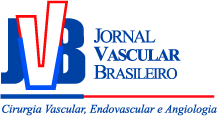Uso do azul de metileno na reversão de vasoplegia refratária ao uso de catecolaminas após bypass aortobifemoral
Use of methylene blue in the reversal of vasoplegia refractory to the use of catecholamines after aortobifemoral bypass
Mariana Raphaela Garcia de Araújo dos Santos; Luis Gustavo Campos da Silva; Paulo Roberto Barbosa Evora; Carlos Eli Piccinato; Edwaldo Edner Joviliano
Resumo
Palavras-chave
Abstract
Keywords
References
Kilbourn RG, Traber DL, Szabo C. Nitric oxide and shock. Dis. Mon.;43:277-348.
Evora PRB, Seccombe JF, Pearson PJ, Schaff HV. O papel do oxido nítrico e perspectivas terapêuticas na sepse bacteriana. Ver Bras Terap Intens.. 1994;6:105-7.
Schneider F. Methylene blue infusion in septic shock. Crit Care Med.. 1995;23:1935-1936.
Osada S, Ichiki H, Oku H, Ishiguro K, Kunitomo M, Semma M. Participation of nitric oxide in mouse anaphylactic hypotension. Eur J Pharmacol.. 1994;252:347-50.
Wan S, Leclerc JL, Vincent JL. Inflammatory response to cardiopulmonary bypass: Mechanisms involved and possible therapeutic strategies. Chest.. 1997;112:676-92.
Winnock S, Janvier G, Cesarini M. Hemodinamic changes caused by laparotomy during aorto-iliac surgery. Ann Fr Reanim.. 1987;6:471-5.
Seghaye MC, Duchateau J, Grabitz GR. Complement activation during cardiopulmonary bypass in infants and children: relation to postoperative multiple system organ failure. J Thorac Cardiovasc Surg.. 1993;106:978-87.
Patrick DA, Moore EE, Fullerton DA. Cardiopulmonary bypass renders patients at risk for multiple organ failure via early neutrophil priming and late neutrophil disability. J Surg Res.. 1999;86:42-9.
Pearson PJ, Evora PRB, Ayrancioglu K, Schaff HV. Protamine releases endothelium-derived relaxing factor from systemic arteries: a possible mechanism of hypotension duryng heparin neutralization. Circulation.. 1992:86;289-94.
Evora PRB, Roselino CHCD, Schiaveto PM. Methylene blue in anaphylatic shock. Ann Emeg Med.. 1997;30:240.

